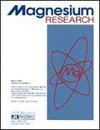Coordination between antioxidant defences might be partially modulated by magnesium status.
IF 1.5
4区 医学
Q4 BIOCHEMISTRY & MOLECULAR BIOLOGY
引用次数: 12
Abstract
The aim of this study was to compare the redox balance in competitive adult swimmers against recreational practitioners, controlling for Mg intake. Fifteen, competitive swimmers and 16 recreational practitioners, all male and aged 18-25years, were recruited into the study. Oxidative and muscle damage markers, and antioxidant enzymes and non-enzymatic antioxidants were evaluated by photometry (except for thiobarbituric reactive substances (TBARS), which was assessed by fluorimetry). Controlling for the level of exercise, inverse correlations were observed for uric acid and glutathione reductase (GR) or susceptibility of red blood cells to peroxidation (RBCPx); plasma adrenaline oxidase activity (AdOx) and carotenoids; TBARS and GR or Vit E; and direct correlations were observed between AdOx and creatine kinase (CK) or TBARS; CK and superoxide dismutase activity; GR and RBCPx. Controlling for Mg intake in addition to exercise level revealed new inverse correlations: between carotenoids and TBARS or lactate, and new direct correlations between lactate and AdOx or TBARS; cortisol and AdOx, CK, lactate dehydrogenase, or methemoglobin reductase. The associations between uric acid and RBCPx; AdOx and CK or TBARS; and GR and RBCPx lost their significance. All others remained significant. These outcomes suggest that the coordination between antioxidant defences may be partially modulated by Mg, which may be the result of its ability to stabilize cell membranes and oxidation targets, such as adrenaline.抗氧化防御之间的协调可能部分由镁状态调节。
本研究的目的是在控制镁摄入量的情况下,比较竞技成年游泳运动员和休闲游泳运动员的氧化还原平衡。研究招募了15名竞技游泳运动员和16名休闲运动员,均为男性,年龄在18-25岁之间。氧化和肌肉损伤标志物、抗氧化酶和非酶抗氧化剂用光度法进行评价(硫代巴比妥反应性物质(TBARS)除外,用荧光法进行评价)。在控制运动水平的情况下,观察到尿酸和谷胱甘肽还原酶(GR)或红细胞过氧化敏感性(RBCPx)呈负相关;血浆肾上腺素氧化酶活性(AdOx)和类胡萝卜素;TBARS和GR或Vit E;AdOx与肌酸激酶(CK)或TBARS呈正相关;CK和超氧化物歧化酶活性;GR和RBCPx。在运动水平的基础上控制Mg摄入量揭示了类胡萝卜素与TBARS或乳酸之间的新的负相关关系,以及乳酸与AdOx或TBARS之间的新的直接相关关系;皮质醇和AdOx, CK,乳酸脱氢酶,或高铁血红蛋白还原酶。尿酸与RBCPx的关系ox和CK或TBARS;GR和RBCPx失去了意义。其他的都很重要。这些结果表明,抗氧化防御之间的协调可能部分由Mg调节,这可能是其稳定细胞膜和氧化目标(如肾上腺素)的能力的结果。
本文章由计算机程序翻译,如有差异,请以英文原文为准。
求助全文
约1分钟内获得全文
求助全文
来源期刊

Magnesium research
医学-内分泌学与代谢
CiteScore
3.50
自引率
9.40%
发文量
6
审稿时长
>12 weeks
期刊介绍:
Magnesium Research, the official journal of the international Society for the Development of Research on Magnesium (SDRM), has been the benchmark journal on the use of magnesium in biomedicine for more than 30 years.
This quarterly publication provides regular updates on multinational and multidisciplinary research into magnesium, bringing together original experimental and clinical articles, correspondence, Letters to the Editor, comments on latest news, general features, summaries of relevant articles from other journals, and reports and statements from national and international conferences and symposiums.
Indexed in the leading medical databases, Magnesium Research is an essential journal for specialists and general practitioners, for basic and clinical researchers, for practising doctors and academics.
 求助内容:
求助内容: 应助结果提醒方式:
应助结果提醒方式:


